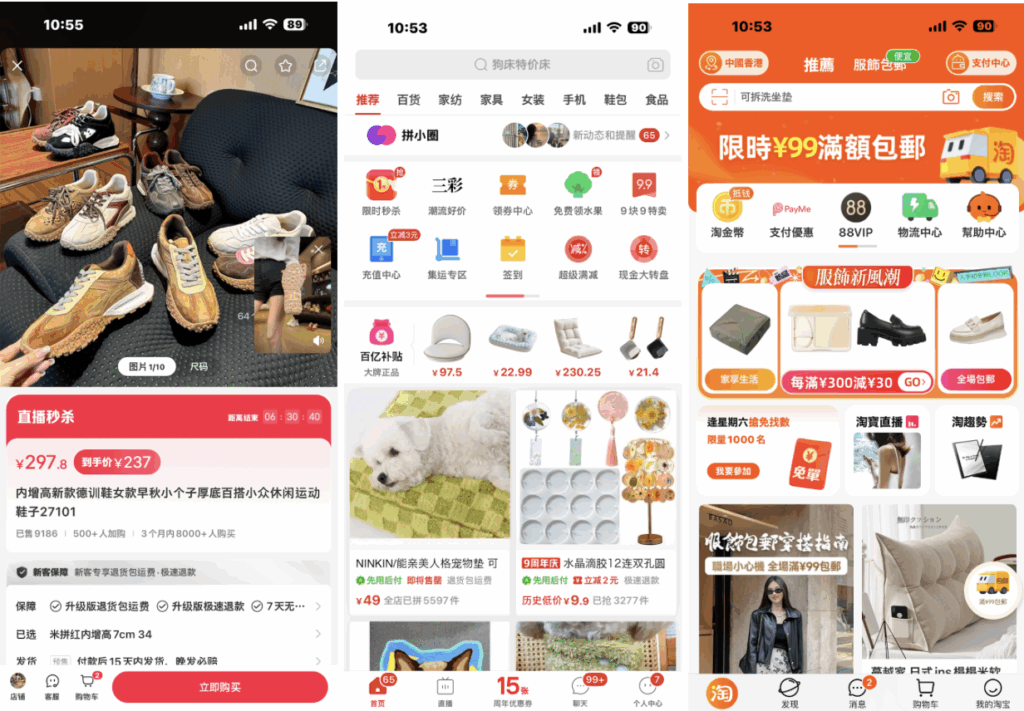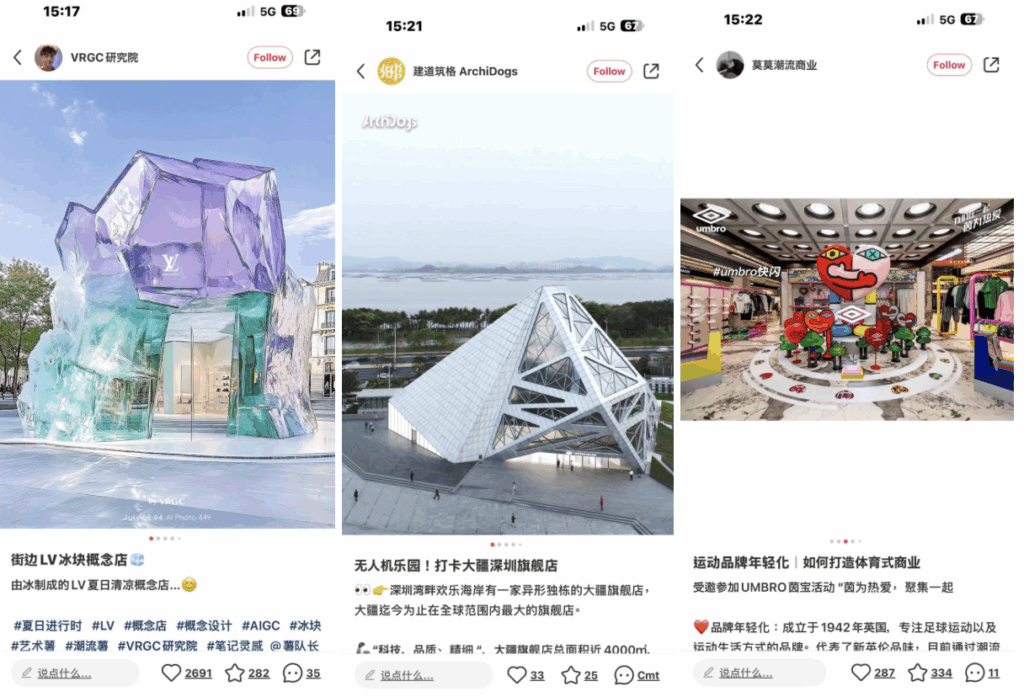
China Retail Market: Trends, Growth, and Reinventing the Customer Experience
By: Ashley Dudarenok
Updated:
China’s retail market is experiencing robust growth, with the sector’s size estimated to reach USD 1.94 trillion in 2024 and projected to expand to USD 2.87 trillion by 2029, growing at a CAGR of 8.17%. This growth is fueled by rising disposable incomes, rapid urbanization, and the proliferation of e-commerce platforms like Alibaba’s Tmall and JD. In the first half of 2024, online retail sales surged to 7 trillion yuan (US$981 billion), marking a 9.8% year-on-year increase. The food and grocery sector dominated the market in 2022, while clothing and footwear are expected to show the highest growth rate in the coming years.The China retail market is undergoing a significant transformation, driven by technological innovation and changing consumer preferences. Retailers are leveraging artificial intelligence, big data analytics, and augmented reality to enhance customer engagement and personalize marketing strategies. The rise of live-streaming e-commerce and instant delivery services has contributed to an 8.8% increase in online retail sales of physical goods in 2024. Moreover, cross-border e-commerce is playing an increasingly important role, with Chinese consumers showing a growing appetite for foreign brands and luxury goods. As the market evolves, retailers are focusing on delivering higher-quality products, personalized shopping experiences, and convenient services to meet the demands of increasingly sophisticated Chinese consumers, further shaping the China retail market.

To succeed in this dynamic and rapidly evolving market, businesses need expert insights and strategic guidance. This is where ChoZan comes in. ChoZan offers a comprehensive suite of services designed to help companies understand and learn from China. Our offerings include learning expeditions, research and strategy services, keynote presentations, consulting, and expert dialogues. These services are tailored to provide businesses with the knowledge and tools they need to thrive in China’s complex retail market.
The China Retail Market
The China retail market is a dynamic and expansive ecosystem valued at approximately $5 trillion in 2024, integrating both traditional and modern retail formats. This market spans urban megacities and rural regions, presenting diverse opportunities for online and brick-and-mortar retailers. The rapid advancement in mobile payments, social commerce, and omnichannel strategies has positioned China as a global leader in retail innovation.
The transformation of the retail landscape is primarily driven by a burgeoning middle class, increasing urbanization, and widespread digital adoption. Younger Chinese consumers are particularly focused on high-quality products and seamless shopping experiences that blend online and offline interactions. This shift is exemplified by the growing popularity of shopping apps and platforms that cater to evolving consumer preferences, reinforcing the dynamic growth of the China retail market.

As the market evolves, several key trends are emerging:
- Technological Innovation: Retailers are increasingly adopting advanced technologies such as AI and big data to enhance customer engagement and streamline operations.
- E-commerce Growth: The rise of e-commerce continues to reshape the retail landscape, with significant contributions from platforms like Alibaba and JD.com.
- Changing Consumer Preferences: Consumers are becoming more discerning, prioritizing quality, sustainability, and personalized shopping experiences.
- Lower-Tier Market Expansion: Retailers are recognizing the potential in lower-tier cities, adapting strategies to meet the unique needs of these consumers.
- The China retail market is characterized by its rapid evolution and the need for retailers to innovate continuously. Understanding these dynamics is crucial for businesses aiming to thrive in this competitive landscape.
The China retail market is a massive $5 trillion ecosystem that blends traditional and modern retail formats. It spans from megacities to rural areas, offering opportunities for both online and brick-and-mortar stores. The market’s rapid innovation in mobile payments, social commerce, and omnichannel integration has made China a global retail trendsetter.
Overview of China Retail Market
China’s retail market has seen major changes in recent years. As the world’s second-largest economy, China’s retail sector is crucial for businesses. This overview will look at the current state of the China retail market, including its size, growth projections, and key trends. Understanding this complex and fast-changing market is key for retailers to take advantage of the huge opportunities it presents. The following sections will analyze the China retail market in depth, from market size and growth to the rise of e-commerce and evolving consumer preferences.
China Retail Market: Size and Growth Projections
While China’s retail market has shown resilience and adaptability in recent years, it’s important to note that the current recovery is progressing more slowly than initially anticipated. The market is facing several challenges that are tempering its growth trajectory. China’s retail sales have been experiencing a gradual recovery, but the pace has been slower than expected. This is due to a combination of factors, including dampened consumer confidence, ongoing economic uncertainties, and shifts in spending patterns. The retail sector is grappling with issues such as falling home prices and concerns about job security, which are causing consumers to be more cautious with their spending.
Despite these challenges, there are signs of improvement. Beijing’s retail property market, for instance, saw a drop in vacancy rates and an increase in rental rates in the last quarter of 2023, indicating some positive momentum. However, the recovery is uneven across different cities and sectors. In Shanghai, while demand for retail leasing grew, it was offset by an increase in supply, leading to a slight rise in vacancy rates.
Looking ahead, experts project that retail sales will continue to grow, albeit at a more modest pace. UBS estimates retail sales will climb 5.5% in 2024, down from an estimated 6.5% in 2023. This slower growth reflects the ongoing challenges in the market, including consumers’ reluctance to tap into their savings and a preference for value-driven choices. However, as economic conditions stabilize and consumer confidence gradually improves, the retail sector is expected to see a more robust recovery. The key for retailers will be to adapt to changing consumer behaviors, offer compelling value propositions, and create engaging shopping experiences to stimulate spending and drive growth in this evolving market landscape, reinforcing the resilience of the China retail market.
China Retail Market: The Rise of E-Commerce
E-commerce continues to shape China’s retail landscape, with online retail sales reaching 15.4 trillion yuan ($2.14 trillion) in 2023, representing a 10.9% year-on-year increase and accounting for 28.2% of total retail sales. Tech giants Alibaba and JD remain at the forefront of this digital transformation, but emerging players like Pinduoduo and Douyin are gaining significant market share, diversifying the e-commerce ecosystem. The sector’s growth is driven by innovative features such as live-streaming commerce, social shopping, and improved logistics networks, catering to evolving consumer preferences and enhancing the overall online shopping experience. These advancements continue to strengthen the China retail market.
These platforms fuse social media, entertainment, financial services, and logistics into comprehensive digital environments. Their success has sparked a surge in Chinese shopping apps, each competing for market share. These apps now offer advanced features like AR try-ons, livestream shopping, and AI-driven recommendations.

Several factors fuel China’s e-commerce boom: widespread smartphone use, sophisticated mobile payments, and efficient logistics. China boasts one of the world’s highest e-commerce penetration rates, with projections suggesting 83.9% of the population will shop online by 2025. This digital shift forces traditional retailers to innovate or risk obsolescence. Retailers increasingly adopt omnichannel strategies, blending online and offline experiences. They strive to create memorable customer journeys that combine online convenience with in-store tactile benefits. E-commerce growth drives sophisticated marketing strategies. Brands harness big data, AI, and machine learning for targeted campaigns and personalized recommendations. Social commerce, integrating shopping with social media, blurs the line between social interaction and purchasing, further shaping the China retail market.
Evolving Consumer Preferences in the China Retail Market
Chinese consumers have transformed significantly in recent years, becoming more sophisticated and discerning in their purchasing decisions. A rising middle class of around 700 million individuals drives demand for high-quality products, premium brands, and luxury goods, particularly in fashion, beauty, and electronics. Consumers are willing to pay more for products offering superior quality, innovative features, or strong brand prestige, reinforcing the evolution of the China retail market.
As consumers prioritize health, wellness, and sustainability, their purchasing decisions are influenced across various product categories, from food and beverages to personal care items. This trend is reflected in China’s consumer spending patterns, with households allocating more of their budgets to health-related products and services. Chinese retailers are rapidly adapting to meet the evolving demands of younger shoppers who value personalized experiences, convenience, and superior customer service. This shift is driving innovative approaches across the retail landscape.
Personalization has become a key focus, with retailers leveraging data and AI to tailor offerings. For example, Alibaba’s Tmall Luxury Pavilion uses AI to create personalized product recommendations and virtual try-on experiences for high-end fashion items. This approach has led to increased engagement and sales, with some luxury brands reporting up to 40% higher conversion rates compared to traditional e-commerce platforms.
Convenience is another critical factor, exemplified by JD.com’s innovative delivery methods. The company has implemented drone deliveries in rural areas and 30-minute delivery windows in major cities. This focus on speed and accessibility has contributed to JD.com’s rapid growth, with the company reporting a 29.2% increase in annual active customer accounts in 2022.
Experiential retail is gaining traction as a way to differentiate and engage customers. Burberry’s social retail store in Shenzhen showcases this trend, blending physical and digital experiences through a dedicated WeChat mini-program. Customers can unlock exclusive content, personalize their in-store experience, and earn social currency, resulting in increased foot traffic and higher average transaction values.

The integration of online and offline channels is becoming increasingly seamless. Hema Fresh, Alibaba’s grocery chain, exemplifies this trend with its “New Retail” concept. Customers can shop in-store, order online for home delivery, or use the store as a fulfillment center for online orders. This omnichannel approach has led to impressive results, with Hema Fresh stores achieving sales per unit area up to five times higher than traditional supermarkets.
The New Retail Revolution in the China Retail Market
The concept of “New Retail,” pioneered by Alibaba founder Jack Ma, is reshaping the China retail market landscape in profound ways. This innovative model blurs the lines between online and offline shopping, creating seamless, omnichannel experiences for consumers. At its core, New Retail leverages data and technology to integrate all aspects of commerce, from inventory and supply chain management to marketing and customer service. This approach allows retailers to offer personalized experiences, optimize operations, and gather valuable insights into consumer behavior.
In practice, China New Retail appears in various forms across the China retail market. Smart stores equipped with digital price tags, facial recognition payment systems, and interactive displays are becoming increasingly common. Augmented reality (AR) technology is being used to allow customers to virtually try on products or visualize furniture in their homes before making a purchase. Data-driven personalization enables retailers to offer tailored product recommendations and targeted promotions both online and in-store. The New Retail paradigm is not only enhancing customer experiences but also driving operational efficiencies for retailers, allowing them to better manage inventory, reduce costs, and increase sales. As this model continues to evolve, it’s likely to further transform the retail landscape, setting new standards for customer engagement and operational excellence.

Lower-Tier Market Expansion
While China’s tier-1 and tier-2 cities have long been the focus of retail expansion, there’s growing recognition of the immense potential in lower-tier markets. These cities and rural areas represent a significant portion of China’s population and are experiencing rapid economic growth, with rising disposable incomes and increasing consumer sophistication. Retailers are adapting their strategies to cater to these markets, often leveraging e-commerce and social commerce platforms to reach previously underserved consumers. This expansion into lower-tier markets is not just about geographical reach; it’s about tapping into a vast consumer base with unique preferences and behaviors.
The approach to lower-tier market expansion in the China retail market often differs from strategies employed in major cities. Retailers are finding success by offering products tailored to local tastes and price points, as well as by adapting their marketing and distribution strategies to suit local contexts. E-commerce platforms have played a crucial role in this expansion, with companies like Pinduoduo gaining significant market share by focusing on value-for-money products and group buying models that resonate with lower-tier consumers. As these markets continue to develop, they are likely to become increasingly important drivers of growth in the China retail market, offering opportunities for both established players and new entrants to capture market share and drive innovation.
A notable case study is Lululemon’s successful expansion into China’s lower-tier cities. By adapting their product offerings to local tastes and preferences, Lululemon has been able to tap into the growing demand for premium athletic wear in these markets . Additionally, the company has leveraged e-commerce platforms like Pinduoduo to reach a wider audience and offer value-for-money products that resonate with lower-tier consumers. This approach has enabled Lululemon to establish a strong presence in China’s lower-tier cities, underscoring the potential of these markets as a key driver of growth for the company.
Key Drivers and Challenges in the China Retail Market
The China retail market is a powerhouse, with a massive scale and rapid evolution that’s shaped by a complex interplay of drivers and challenges. In 2023, China’s retail sales reached 44.08 trillion yuan (approximately $6.8 trillion), a 12.5% year-on-year increase, according to the National Bureau of Statistics of China. This growth is fueled by technological innovations that reshape consumer experiences and government policies that stimulate domestic consumption.
One key driver is China’s digital economy, valued at 39.2 trillion yuan (about $6 trillion) in 2022, accounting for 38.6% of the country’s GDP . However, retailers face unique challenges, including logistical hurdles due to China’s vast size and diversity, with e-commerce penetration varying significantly between urban and rural areas. In 2021, e-commerce accounted for 52.1% of total retail sales, but this figure masks regional disparities . The competitive landscape is intensifying, with over 70 million micro and small enterprises operating in China, many in the retail sector.
To face these challenges, retailers must understand the key drivers and challenges shaping the China retail market.
Key Drivers in the China Retail Market
Technological Innovation Driving the China Retail Market
China retail market is at the forefront of technological innovation, setting global benchmarks for integrating cutting-edge technologies into retail operations. Artificial intelligence (AI), big data analytics, and the Internet of Things (IoT) are being leveraged across the retail value chain, from predictive inventory management to personalized customer recommendations.
One of the most visible manifestations of this innovation is the proliferation of unmanned stores and facial recognition payment systems. Companies like Alibaba and JD.com have launched concept stores that showcase technologies such as computer vision, sensor fusion, and deep learning to create frictionless shopping experiences. These innovations not only enhance convenience for consumers but also provide retailers with valuable data on shopping patterns and preferences.

Mobile-First Consumer Behavior in the China Retail Market
China’s mobile-centric culture has profoundly shaped its retail landscape, with smartphones serving as the primary gateway for consumers to interact with brands, discover products, and make purchases. With over 983 million social media users, platforms like WeChat and Douyin have evolved beyond communication tools to become powerful channels for social commerce.
The ubiquity of mobile payments through services like Alipay and WeChat Pay has further streamlined the purchasing process, making mobile an indispensable part of the retail journey. These payment systems have expanded beyond simple transactions to offer a range of financial services, loyalty programs, and even social features. This seamless integration of mobile technology across all touchpoints has raised consumer expectations for convenience and personalization in China retail market.
E-Commerce Growth in the China Retail Market
The e-commerce sector in China retail market continues to experience robust growth, with online retail sales reaching 7.0991 trillion RMB in the first half of 2024, marking a 9.8% year-on-year growth. E-commerce now accounts for 25.3% of total retail sales, indicating its significant role in the overall retail landscape. This growth is particularly noteworthy given that China’s total retail sales of consumer goods reached 47.15 trillion yuan in 2023, representing a 7.2% increase from the previous year.
The rapid expansion of e-commerce is driven by factors such as improved logistics networks, innovative online-to-offline (O2O) models, and the increasing penetration of e-commerce in lower-tier cities. Platforms like Alibaba’s Taobao and JD.com continue to dominate, while newer entrants like Pinduoduo have gained significant market share by targeting price-sensitive consumers in smaller cities and rural areas. The clothing and footwear sector is anticipated to have the highest growth rate during the forecast period, while online electrical sales are expected to increase prominently by 2027.
Emerging Consumer Trends in the China Retail Market
New consumption patterns are emerging in China retail market, including digital consumption, green consumption, health consumption, and “China-chic” products. These trends reflect changing consumer values and preferences, particularly among younger generations. The surge in service sales, which grew by 20.3% year-on-year in the first seven months of 2023, outpacing the 7.3% growth in overall retail sales, demonstrates this shift in consumer behavior.
For instance, the rise of “China-chic” or “guochao” products demonstrates a growing preference for domestic brands that incorporate traditional Chinese elements with modern design. This trend has led to the success of many local brands across various retail categories, from cosmetics to fashion. The increasing sophistication of China’s consumption landscape is further evidenced by the growth in per capita service consumption expenditure, which saw a notable increase of 12.7% year-on-year in the first half of 2023.

Key Challenges in the China Retail Market
Supply Chain and Logistics Complexities in the China Retail Market
China’s vast geographical expanse and regional disparities pose significant logistical challenges for retailers. According to a report by the World Bank, China’s Logistics Performance Index (LPI) score in 2023 was 3.75, ranking 26th globally. While this represents an improvement from previous years, there is still room for optimization, especially in terms of infrastructure and logistics competence in lower-tier cities and rural areas. A survey by the China Federation of Logistics and Purchasing found that in 2023, the average logistics cost as a percentage of GDP in China was 14.5%, which is higher than developed countries like the United States (8%) and Japan (10%). This highlights the need for retailers to invest in supply chain optimization and adopt innovative solutions to reduce costs and improve efficiency in China retail market.
Intense Competition and Market Saturation Challenges in the China Retail Market
The China retail market is highly competitive, with numerous players vying for market share. According to the National Bureau of Statistics of China, there were over 4.6 million retail enterprises in China as of 2023, with a year-on-year growth rate of 7.2%. This intense competition has led to market saturation in some segments, particularly in e-commerce and certain product categories in tier-1 cities. A report by McKinsey & Company found that in 2023, the online penetration rate for fast-moving consumer goods (FMCG) in tier-1 cities reached 35%, while in lower-tier cities, it was around 25%. This indicates that there is still room for growth in lower-tier markets, but retailers must adapt their strategies to cater to local consumer preferences and purchasing power.

Regional Disparities and Changing Consumer Behavior in the China Retail Market
China’s regional disparities in terms of economic development, consumer behavior, and digital adoption present challenges for retailers. According to the China Internet Network Information Center (CNNIC), the internet penetration rate in urban areas reached 80.3% in 2023, while in rural areas, it was only 57.6%. This digital divide affects e-commerce adoption and consumer engagement across different regions.
A survey by the China Chain Store & Franchise Association found that in 2023, the average monthly household income in tier-1 cities was 12,500 RMB, while in tier-3 cities, it was 7,500 RMB. This income disparity influences consumer spending power and preferences, requiring retailers to tailor their offerings and pricing strategies accordingly.
Economic Uncertainty and Cautious Consumer Spending
Economic uncertainty and slower growth have impacted consumer confidence and spending in China. According to the National Bureau of Statistics of China, the Consumer Confidence Index (CCI) in May 2024 was 120.9, a slight improvement from the previous month but still lower than pre-pandemic levels. These fluctuations highlight the evolving dynamics of the China retail market.
A report by Bain & Company found that in 2023, 60% of Chinese consumers were more cautious about spending due to economic uncertainty, with 45% of respondents stating that they would prioritize essential goods over discretionary purchases. Retailers must adapt to these changing consumer sentiments by offering value-for-money propositions and focusing on essential product categories.
Regulatory Environment and Compliance Challenges
China’s evolving regulatory landscape poses compliance challenges for retailers. In recent years, the government has introduced stricter regulations on data privacy, e-commerce, and anti-monopoly practices. For example, the Personal Information Protection Law (PIPL), which came into effect in November 2021, sets stringent requirements for the collection, processing, and protection of personal data. A survey by PwC found that in 2023, 65% of Chinese consumers were concerned about the privacy and security of their personal data when shopping online. Retailers must navigate these regulatory complexities while ensuring compliance and building trust with consumers.
The China retail market presents a complex arena of opportunities and challenges. As we’ve explored the key drivers and obstacles shaping this ever-changing sector, it’s clear that success requires a deep understanding of the market’s unique characteristics. To maneuver through this complex environment effectively, many businesses turn to specialized expertise. This is where ChoZan’s insights and guidance come into play, offering valuable support for companies looking to thrive in China’s retail scene.
China’s Retail Market with ChoZan’s Expertise
ChoZan provides valuable insights into China’s rapidly changing retail sector, helping businesses learn from the China retail market. ChoZan research indicates that China’s retail market is projected to grow at a compound annual rate exceeding 9% by 2026. This significant expansion is driven by several key factors:
- Digital transformation: China’s retail industry has fully embraced digital technologies, blurring the lines between online and offline shopping. E-commerce giants like Alibaba and JD.com have created seamless ecosystems integrating online marketplaces, payment systems, and logistics networks.
- New Retail concept: This approach combines the best elements of online and offline retail. Physical stores are transformed into experiential spaces where customers can interact with products and make purchases seamlessly.
- Personalization through AI and big data: Chinese retailers are leveraging artificial intelligence and data analytics to offer tailored product recommendations and enhance customer experiences.
- Social commerce: Platforms like WeChat and Xiaohongshu have integrated e-commerce features, enabling users to discover, share, and purchase products within the same app.
ChoZan超赞 offers comprehensive consulting services tailored to help businesses thrive and learn in China’s rapidly evolving retail landscape. For straightforward challenges, ChoZan provides focused one-hour presentations or full-day training sessions. More complex projects benefit from ongoing consultations spanning 3-12 months, delivering in-depth analysis and facilitating organizational transformation. This service is particularly valuable for companies undergoing digital transformation, updating their technology stack, or entering the Chinese market for the first time. By leveraging ChoZan’s expertise, businesses can effectively navigate the complexities of modernizing their operations and successfully integrate cutting-edge technologies into their retail strategies.
One of ChoZan’s key strengths is its ability to bridge the gap between Western business practices and China’s unique retail ecosystem. For example, ChoZan helped a global cosmetics brand understand the importance of live streaming in China’s beauty industry. Through tailored training sessions and market research, ChoZan guided the brand in developing a successful live streaming strategy on platforms like Taobao Live and Douyin, resulting in a 15% increase in online sales within six months. This case demonstrates how ChoZan’s expertise can translate into tangible business results for companies navigating China’s retail landscape.
Meet ChoZan (超赞): Stay Tuned for Insights into China Retail Market
At ChoZan (超赞), companies gain invaluable insights into China retail market through a comprehensive suite of services, including consultations and innovation tours. By providing an independent perspective, ChoZan presents findings objectively, free from internal biases that might protect outdated systems. With deep expertise in China’s retail market and extensive experience with large organizations, ChoZan delivers effective guidance through digital transformation. This involves introducing creative problem-solving approaches and communicating them directly to upper management, resulting in swift and cost-effective goal achievement. The industry-wide view provided highlights best practices and competitor strategies, essential for making well-informed strategic decisions. This comprehensive approach not only addresses immediate challenges but also sets the stage for significant future benefits and enhanced business preparedness.
ChoZan’s extensive range of services includes:
- Innovation Tours: ChoZan’s tours offer access to China’s leading retail companies and experts, with expertly crafted itineraries and knowledgeable guides. For example, ChoZan facilitated a retail tour for Haier, connecting them with local retail distributors and innovation hubs. This provided valuable insights and inspirations from both traditional Chinese retail practices and contemporary trends, enhancing their understanding of the local retail market.
- Keynotes and Training Sessions: Engaging keynotes and training sessions are led by seasoned professionals, providing valuable insights and practical strategies. Collaborations with renowned companies such as Meituan, RED, and ByteDance have resulted in impactful presentations on customer centricity, the future of retail, digital ecosystems, business strategies, and leadership models. These sessions offer the knowledge needed to navigate and thrive in China retail market.
- Market Research and Strategy Planning: In-depth market research and customized strategy planning are tailored to align with business goals. ChoZan’s consultants conduct detailed analyses and provide strategic recommendations to help companies seize new market opportunities and enhance growth. For instance, a comprehensive brand audit for Perfect Diary’s e-commerce presence in China delivered insights that optimized their digital strategy and aligned with local consumer preferences.
- Consulting Services and Expert Dialogues: Personalized guidance and innovative solutions are provided through consulting services and expert dialogues. By connecting with China-based industry experts and subject matter professionals, ChoZan facilitates a deep understanding of specific areas of interest. This holistic approach ensures exceptional quality and supports long-term success across all aspects of business.
Through these diverse offerings, ChoZan equips businesses with the tools and knowledge needed to stay ahead in China’s innovation landscape, fostering growth and strategic success in a rapidly evolving market.
Join Thousands Of Professionals
By subscribing to Ashley Dudarenok’s China Newsletter, you’ll join a global community of professionals who rely on her insights to navigate the complexities of China’s dynamic market.
Don’t miss out—subscribe today and start learning for China and from China!
Latest posts


What Is Douyin? How Brands Are Winning Big on China’s TikTok
September 25, 2025

What Is Market Research? How It Works in the Chinese Market
September 24, 2025
SOCIAL MEDIA
What Are the Fastest-Growing Retail Categories in the China Retail Market?
Food has indeed emerged as the fastest-growing online retail category in China, reflecting changing consumer habits and the increasing popularity of online grocery shopping and food delivery services. According to data from 2022, the fresh food e-commerce market in China reached a gross merchandise value (GMV) of 458.5 billion yuan, showing significant growth potential. The food and beverage segment has been a major contributor to the overall retail market in China, with the industry being the largest sector in terms of financial gain and employment opportunities. This trend underscores the evolving dynamics of the China retail market.
Other categories experiencing significant growth include consumer electronics, fashion, and beauty products. In 2022, the nominal retail sales value in the clothing, shoes, hats, and textiles sector reached approximately 1.3 trillion yuan. The beauty and personal care market has also been expanding rapidly, with the market size of the cosmetics industry in China reaching about 425.6 billion yuan in 2021. Additionally, the home appliance sector showed signs of recovery, driven by pent-up demand and a rebound in the property market. The year-on-year change in monthly retail sales revenue for April 2024 was reported at 2.3%, indicating a moderate but steady growth in the overall retail sector
How significant is e-commerce in China's retail market landscape?
E-commerce is a dominant force in the China retail market, with online retail sales reaching 15.43 trillion yuan (about $2.39 trillion) in 2023, accounting for a substantial portion of total retail sales. The country has one of the most advanced and innovative e-commerce ecosystems globally, with platforms like Alibaba's Tmall and JD.com dominating the market. The COVID-19 pandemic has further accelerated the shift towards online shopping, with many consumers embracing digital channels for their retail needs.
What are the fastest-growing retail categories in China?
Food has emerged as the fastest-growing online retail category in China in 2023. This trend reflects changing consumer habits and the increasing popularity of online grocery shopping and food delivery services. Other categories experiencing significant growth include consumer electronics, fashion, and beauty products. The home appliance sector is also showing signs of recovery, driven by pent-up demand and a rebound in the property market. These developments highlight the evolving nature of the China retail market.
How are Chinese consumers' preferences evolving in the China Retail Market?
New Retail, a term coined by Alibaba founder Jack Ma, refers to the integration of online and offline retail experiences. This concept has gained significant traction in China, with many retailers adopting omnichannel strategies to provide seamless shopping experiences. Examples include the rise of unmanned stores, smart vending machines, and the use of augmented reality in physical retail spaces. The market value of unmanned retail services in China is projected to grow substantially in the coming years, reflecting the increasing adoption of these innovative retail models. These advancements continue to reshape the China retail market.
What role do private-label brands play in the China Retail Market?
Private-label brands are gaining popularity in China's retail market. Major retailers are increasingly focusing on developing their own private-label products across various categories, including packaged foods, beverages, and personal care items. These products often offer competitive pricing compared to established brands, appealing to price-conscious consumers. The growing trust in retailer brands and their ability to offer quality products at lower prices is driving the expansion of private-label offerings in the Chinese market.
How are lower-tier cities impacting the China retail market?
Lower-tier cities and rural areas are having a substantial impact on China retail market, driving significant growth and prompting retailers to adapt their strategies. As of 2022, lower-tier cities (Tier 3 and below) accounted for over 70% of China's population and contributed to approximately 59% of total retail sales. These markets have been growing faster than top-tier cities, with a compound annual growth rate of 8.3% between 2017 and 2022, compared to 6.7% for Tier 1 and 2 cities.
The rise of e-commerce has been a key factor in unlocking the potential of lower-tier markets. In 2022, online retail sales in rural areas reached 2.17 trillion yuan, a year-on-year increase of 3.6%. Major e-commerce platforms like JD.com and Alibaba have been expanding their logistics networks to improve delivery times and services in these areas. For instance, JD.com's rural initiative covered over 80% of administrative villages by the end of 2022. Retailers are also adapting their product offerings and marketing strategies to cater to the unique preferences and purchasing behaviors of lower-tier city consumers, who tend to be more price-sensitive but also increasingly brand-conscious.
How can ChoZan help international brands succeed in China's retail market?
ChoZan offers comprehensive consulting and training services to help international brands learn from China's complex retail market. Our "Learn from China, Learn for China" programs provide deep insights into Chinese consumer behavior, digital ecosystems, and retail innovation through immersive market visits and expert-led workshops. We also offer tailored research and strategy development to help brands identify opportunities and develop effective go-to-market plans. For example, we recently helped a global FMCG company refine its e-commerce strategy in China, resulting in a 35% year-on-year increase in online sales. Our team of experts has extensive on-the-ground experience and maintains close relationships with key players in China's retail and tech sectors, allowing us to provide clients with the most up-to-date and actionable insights.
How does ChoZan help clients stay updated on China's rapidly evolving retail market?
ChoZan helps clients stay ahead of China's fast-paced retail environment through our comprehensive trend monitoring and analysis services. We produce regular reports and briefings that distill complex market data into clear, actionable insights. Our team of analysts continuously tracks emerging trends, consumer behaviors, and technological innovations across China's retail sector. We also offer customized trend-watching services tailored to specific industries or product categories. Our China Foresight program provides clients with early warnings about upcoming shifts in the market, allowing them to proactively adjust their strategies. Additionally, we organize expert webinars and workshops throughout the year, bringing together industry leaders to discuss the latest developments and future predictions for China's retail landscape. By leveraging our extensive network and deep local knowledge, we ensure our clients are always well-informed and prepared to capitalize on new opportunities in this dynamic market, strengthening their position in the China retail market.
What are some common challenges foreign companies face when entering the Chinese retail market, and how does ChoZan address them?
Foreign companies often struggle with understanding local consumer preferences, navigating complex regulations, and competing with established domestic brands when entering the Chinese retail market. Language and cultural barriers can also pose significant challenges. ChoZan addresses these issues by providing in-depth market analysis, regulatory guidance, and cultural insights. We help companies localize their products and marketing messages, identify suitable distribution channels, and develop strategies to differentiate themselves from local competitors. Our team also assists with building relationships with key stakeholders and potential partners in China.
How has the rise of social commerce in China impacted traditional retail strategies, and what insights does ChoZan offer on this trend?
Social commerce has dramatically transformed retail strategies in China by blending social media, e-commerce, and entertainment. This shift has led to the rise of livestream shopping, community group buying, and influencer-driven sales. ChoZan offers insights on how brands can leverage these trends through our regular reports and consulting services. We provide data on the most effective social commerce platforms, strategies for engaging with key opinion leaders (KOLs), and case studies of successful campaigns. Our team also helps brands understand how to create seamless omnichannel experiences that integrate online and offline touchpoints.
About The Author
Ashley Dudarenok
Ashley Dudarenok is a leading expert on China’s digital economy, a serial entrepreneur, and the author of 11 books on digital China. Recognized by Thinkers50 as a “Guru on fast-evolving trends in China” and named one of the world’s top 30 internet marketers by Global Gurus, Ashley is a trailblazer in helping global businesses navigate and succeed in one of the world’s most dynamic markets.
She is the founder of ChoZan 超赞, a consultancy specializing in China research and digital transformation, and Alarice, a digital marketing agency that helps international brands grow in China. Through research, consulting, and bespoke learning expeditions, Ashley and her team empower the world’s top companies to learn from China’s unparalleled innovation and apply these insights to their global strategies.
A sought-after keynote speaker, Ashley has delivered tailored presentations on customer centricity, the future of retail, and technology-driven transformation for leading brands like Coca-Cola, Disney, and 3M. Her expertise has been featured in major media outlets, including the BBC, Forbes, Bloomberg, and SCMP, making her one of the most recognized voices on China’s digital landscape.
With over 500,000 followers across platforms like LinkedIn and YouTube, Ashley shares daily insights into China’s cutting-edge consumer trends and digital innovation, inspiring professionals worldwide to think bigger, adapt faster, and innovate smarter.
READ MORE RELATED POSTS








